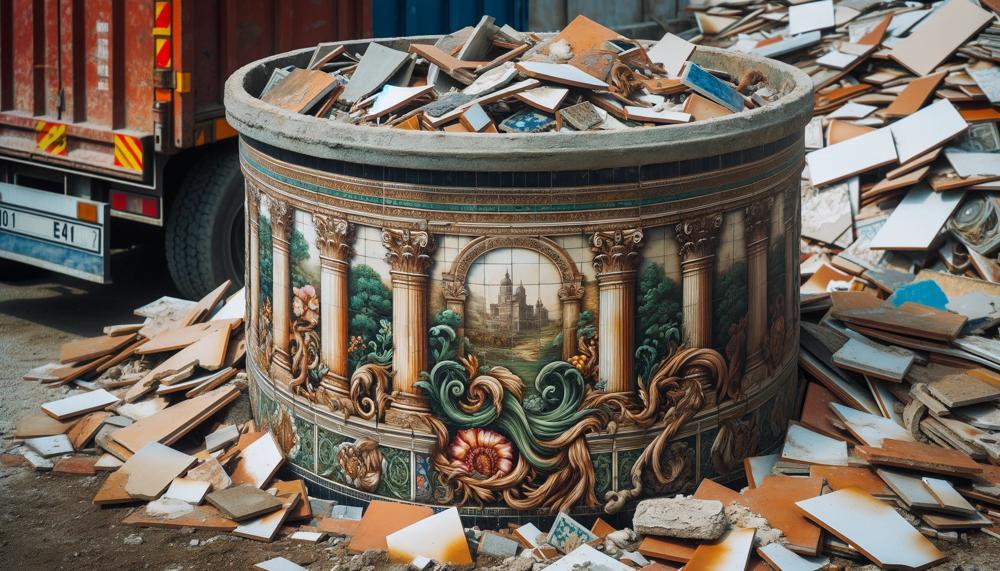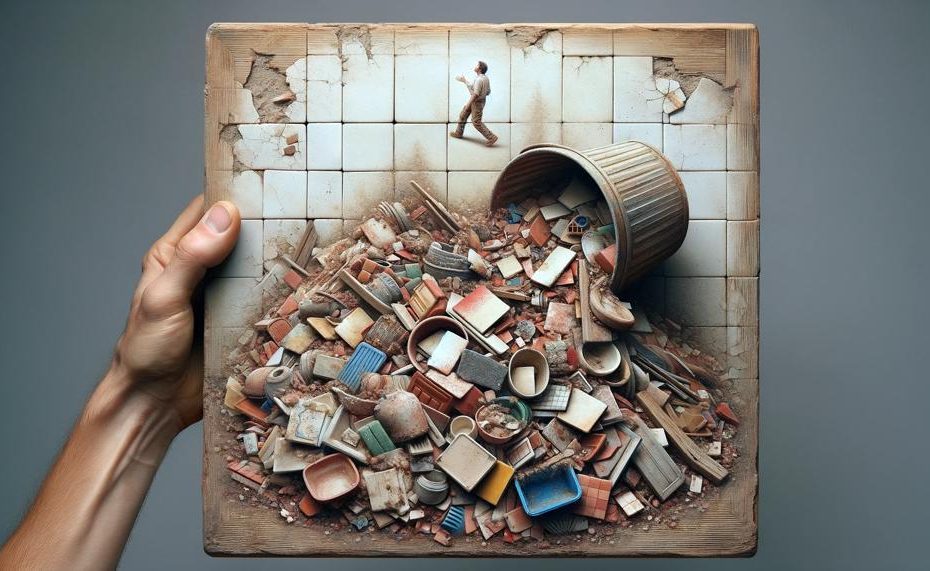After your recent remodeling, are you looking at that pile of old tiles and asking yourself, “Now what?” You’re not alone. How to properly dispose of old tiles is a dilemma that many homeowners face. Although it’s not as easy as throwing them in the trash bin at home, it’s also not as difficult as you would imagine. As part of our commitment to environmental awareness and community service, we are delving deeply into the tile disposal industry. There’s a clever method to get rid of things that are broken, out-of-date, or just not to your liking.
So, how do you dispose of old tiles properly?
You can’t throw old tiles in the trash, but you can take them to a local recycling center, where they will be treated as construction waste. You can also try these other options:
- Donate: If the tiles are still in good condition, you can donate them to local organizations that specialize in renovating or building homes, houses of worship, or even schools. You can contact your local Salvation
- Army, Goodwill, and Value Village to determine if they will take them. You can also donate to local homeless shelters, churches, and community centers.
- Reuse: You can repurpose the tiles in other projects. For example, you can use broken tiles for art projects like mosaics or can be used to decorate pottery. Old ceramic tiles can be broken up and can be used in plant pots.
- Sell: You can sell your tile online.
You can also consider hiring a junk removal company if your local recycling center doesn’t accept tile.
So, let’s roll up our sleeves and tackle this together.

Contents
- 1 How To Dispose Of Old Tiles Properly?
- 2 The Benefits of Recycling Old Tiles
- 3 Creative Ways to Repurpose Old Tiles
- 4 Safety Precautions When Handling Old Tiles
- 5 Alternative Materials for Tiling Projects
- 6 Steps for Removing Ceramic Tiles Safely
- 7 Environmental and Health Risks of Improper Tile Disposal
- 7.1 Environmental Impacts:
- 7.2 Exposure to Toxic Substances: Tiles can contain hazardous materials like asbestos and lead. Improper disposal means these substances can become airborne or seep into water supplies, posing health risks upon exposure. Respiratory Issues: Inhaling dust or fumes from broken tiles, especially during unauthorized incineration, can cause respiratory problems and other health complications. Water Contamination: When harmful chemicals from tiles leach into water supplies, they can lead to serious health issues for communities, including gastrointestinal and skin diseases. Safeguard Measures:
- 8 Conclusion
How To Dispose Of Old Tiles Properly?
To properly dispose of old tiles in safe and eco-friendly ways, consider the following strategies:
Minimise Waste
- Plan Ahead: Calculate the exact number of tiles needed for your project to reduce excess.
Recycling Options
Repurpose for Creativity
- DIY Projects: Transform old tiles into mosaic art, tabletops, or backsplashes.
- School Donations: Offer leftover tiles to schools for arts and crafts.
- Landscaping: Use tiles as unique stepping stones in gardens.
Professional Removal
- Safety First: If removal is necessary, hire a professional to avoid injury.
Eco-Friendly Alternatives
- Consider alternatives like vinyl, laminate, or recycled glass for your next project.
Safe Handling
- Wear protective gear when dealing with old tiles to avoid cuts.
The Benefits of Recycling Old Tiles
Recycling old tiles rather than discarding them offers significant environmental perks. These benefits are crucial in our fight against waste and environmental degradation. Let’s break down the core advantages:
Conservation of Resources
| Resource | Benefit of Recycling | Impact |
| Clay and Sand | Reduces need for new raw materials | Minimises habitat disruption and landscape alteration |
| Water | Less water used in manufacturing | Conserves vital freshwater resources |
| Energy | Saves energy in tile production | Reduces carbon footprint |
Reduction of Greenhouse Gases
Recycling tiles slashes methane emissions by averting landfill disposal. Methane, vastly more potent than CO2, accelerates global warming.
Hence, recycling significantly dials down our greenhouse gas footprint, making a pivotal contribution to climate change mitigation.
Energy Savings
The energy conserved by recycling is monumental. By bypassing the need to extract, process, and manufacture from virgin materials, we save a hefty chunk of energy.
This not only reduces emissions but also eases our dependence on non-renewable energy sources, pushing us closer to a sustainable future.
Waste Minimisation
By repurposing tiles, we keep them out of landfills, where they’d languish for millennia.
This act alone massively reduces the volume of waste we generate, showcasing a straightforward yet profound way to tackle the global waste crisis.
Economic Upsides
The ripple effect of recycling tiles extends to economic benefits. It spurs job creation in recycling and manufacturing sectors and cuts down raw material and waste management costs.
This demonstrates recycling’s role in fostering a circular economy, where waste is not an endpoint but a resource.
Creative Ways to Repurpose Old Tiles
Repurposing old tiles offers a splendid blend of creativity and environmental stewardship, turning what could be waste into wondrous new artefacts. Here’s how to give old tiles a new lease of life:
Home Decor
- Coasters and Trivets: Perfect for protecting surfaces from hot or cold items.
- Framed Mosaics: Create art by arranging broken tiles into beautiful designs.
- Tile-Top Tables: Refresh an old table by adding a tile top for a unique piece.
Garden Enhancements
- Pathway Markers: Lay tiles to create whimsical garden paths.
- Plant Labels: Write on tiles to label plants in your garden.
- Decorative Garden Edging: Use tiles to edge garden beds for a pop of colour.
Unique DIY Projects
- Cheese Boards: Larger, flat tiles can be repurposed as stylish cheese or serving boards.
- Jewellery Organisers: Smaller tiles can be fitted with hooks to hold jewellery.
- Picture Frames: Embellish or mosaic tile frames for a unique look.
Community Contributions
- Local Schools and Art Clubs: Donate tiles for art projects.
- Social Media Giveaways: Offer surplus tiles for free to DIY enthusiasts.
Removal and Prepping Tips:
- Careful Removal: Utilise a grout saw or utility knife to remove tiles with minimal breakage.
- Cleaning: Ensure tiles are clean and free of adhesive before starting your project.
By creatively repurposing tiles, not only do we prevent waste, but we also add a personalised touch to our homes and gardens.
Safety Precautions When Handling Old Tiles
When chucking out old tiles, it’s not just about heaving them into a bin and calling it a day. You’ve got to gear up right to dodge harm’s way. Here’s the lowdown on staying safe:
Mind Your Mitts and Peepers
| Kit | Why It’s a Must | Extra Tip |
| Heavy Gloves | Keeps your digits safe from nasty nicks and cuts. | Pick a pair that’s both tough and snug for better grip. |
| Safety Glasses or Goggles | Avoid getting any rogue particles in your eyes. | Ensure they wrap around for maximum protection. |
Ear and Knee Guards
| Kit | Why It’s a Must | Extra Tip |
| Safety Earmuffs | Power tools can be louder than you think, safeguard your hearing. | Opt for a pair that’s comfortable for long stretches. |
| Knee Pads | Save your knees when you’re down on the ground. | Look for ones with cushioning and a secure fit. |
Breathe Easy
| Kit | Why It’s a Must | Extra Tip |
| Dust Mask or Respirator | Avoid taking in harmful silica dust, especially when slicing through ceramic tiles. | A mask with a rubber faceplate offers both superior protection and comfort. |
Electrical Smarts
- Portable GFCI: Essential when you’re working with power tools near water to prevent a shocking surprise.
By donning the right gear, you turn a potentially perilous job into a walk in the park. So, before you kick off your tile tossing venture, make sure you’re wrapped up right from head to toe.
Alternative Materials for Tiling Projects
For those eyeing eco-friendly alternatives to traditional tile materials for their tiling escapades, here’s a treasure trove of options that marry style with sustainability.
| Material | Pros | Cons |
| Cork Tiles | Renewable, comfortable underfoot, insulating properties | May require sealing to prevent water damage |
| Recycled Glass Tiles | Reduces waste, varied design options, non-porous | Can be slippery, installation demands precision |
| Bamboo Tiles | Strong, sustainable, adds warmth | Sensitive to moisture, may need frequent maintenance |
| Reclaimed Ceramic and Porcelain | Lessens raw material use, energy-efficient | Limited style and quantity options |
Choosing eco-friendly tiling options isn’t just about sprucing up your space—it’s a nod to the planet, acknowledging the role our choices play in crafting a sustainable future.
Steps for Removing Ceramic Tiles Safely
To safely remove and dispose of old ceramic tiles, follow these practical steps. It’s not just about yanking them off the floor or walls but doing it in a way that’s safe for you and kind to the planet. Let’s dive in.
Gear Up for Safety
First things first, you’ve got to suit up like a pro. Safety is paramount.
- Safety glasses to shield your eyes from flying fragments.
- Leather work gloves to protect your hands from sharp edges.
Prep the Battlefield
Clearing the area is like setting the stage for the main event. You need a clean slate.
- Remove obstacles: Get rid of any furniture or fixtures that might get in the way.
- Waterworks: If there are any, disconnect water pipes or drains to prevent a mini flood.
Understanding Your Base
Knowing what lies beneath those tiles is crucial. It’s like knowing the rules of the game before you play.
- Investigate: Determine if your tiles sit on plywood, cement backerboard, or a mortar bed. It’s detective work but worth it.
The Removal Process
Here’s where the action begins. Depending on what your tiles are attached to, the approach varies.
- For mortar beds: Pry them off with gusto using a pry bar.
- Plywood’s prisoners: Show them kindness but firmness with a putty knife or scraper.
- Cement backerboard captives: A hammer and chisel will be your best mates here, chipping away with care.
Disposal with Dignity
Don’t just chuck them out. Old tiles deserve a proper send-off.
- Pack ’em right: Into sturdy containers or bags they go.
- Final destination: A designated disposal area or recycling center that welcomes them.
Environmental and Health Risks of Improper Tile Disposal
Improper disposal of old tiles poses significant risks to our environment and health. Here’s what you need to know:
Environmental Impacts:
Pollution of Soil and Water: Tiles dumped haphazardly can release toxins, contaminating soil and waterways. This contamination harms plant life and aquatic creatures, disrupting local ecosystems.
Air Pollution: Incinerating tiles without proper controls releases harmful gases, contributing to air pollution and exacerbating global warming issues.
Waste Management Strain: Tiles occupying landfill space can lead to increased waste management costs and reduced landfill capacity for other types of waste.
Human Health Risks:





